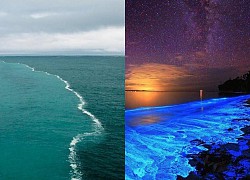Grenada and the countries without an army but an admirable life

3 | 0 Discuss | Share
At a depth of about 3,300 meters below the ocean floor off the coast of the Gulf of Alaska in the Pacific Ocean, where the warm light of the Sun never penetrates, explorers discovered a puzzling yellow object.
Specifically, a remotely operated underwater vehicle of the US National Oceanic and Atmospheric Administration (NOAA) "encountered" a puzzling sight: a strange yellow sphere about 10cm wide clinging to a rock with many white sponges on the seabed.
This unprecedented discovery occurred on August 30, 2023, when NOAA used a ROUV to map deep-sea habitats near Alaska as part of the agency's Seascape Alaska 5 expedition.
Surprisingly, a year has passed and scientists have yet to determine what this yellow sphere is, other than the information that it is of "biological origin."
The soft, smooth, and strange object “has left a lasting impression†on researchers and casual observers alike, NOAA said after its puzzling discovery in 2023.
For the scientists who made the discovery, it is still not entirely clear what the mysterious sphere could be. Initial suggestions from the researchers suggest that it could be an eggshell from a mystery species; or a dead sponge or an unknown species of coral. It could represent a previously undiscovered species, or it could be an existing species going through an unknown life stage.
“Either way, discoveries like this can be very useful. New species have the potential to reveal new sources for medical therapies and vaccines, food, energy, and other societal benefits and knowledge,†said Sam Candio, NOAA Seascape Alaska 5 Expedition Coordinator.
"Isn't the deep sea an interesting oddity? While we were able to collect the golden sphere and bring it aboard, we still can't determine what it is other than the fact that it is biological in origin. This discovery serves as a reminder of how little we know about our own planet and how much there is to discover in our oceans," concluded NOAA's physical scientist.
So, where is the deepest part of the ocean and how deep is it?
If you took the highest point on Earth and plunged it into the ocean, you would still be nearly 2 kilometers away from the deepest point of the ocean. Humans have made two deep-sea discoveries in history. In 1960, oceanographer Jacques Piccard and officer Don Walsh dived to the deepest point in the ocean, the Challenger Deep, at a depth of 7,918 meters.
For decades, that record stood, until explorer Victor Vescovo made three dives to the Challenger Deep in 2019, the deepest of which he went down to 10,923 meters.
Scientists have sent several unmanned submarines to explore the Challenger Deep, with the Kaiko collecting more than 350 specimens from the ocean floor between 1995 and 2003, and they believe there are thousands more species we have never seen before.
Ninety-nine percent of the Earth’s habitable space is under the ocean. To put that in perspective, the average human is about one-sixteenth the length of a blue whale, the largest animal on Earth. Blue whales hunt at depths of about 100 meters below the surface, where they are well lit by the sun.
Even deeper, at 213 meters, the US submarine Triton was the first to circumnavigate the Earth in 1960.
The Austrian diver Herbert Nitsch set a record for the deepest free dive at 253 metres. The pressure here is 26 times higher than at the surface and would crush the lungs of most humans. But blue whales can dive to over 100 metres to hunt giant squid.
During his record-breaking dive, diver Nitsch suffered severe decompression sickness that led to brain damage, but he surfaced and recovered in a hyperbaric oxygen chamber and lived to tell his story.
At 731 meters, we reach the danger zone for modern nuclear attack submarines. Any deeper and the submarine would explode. Continue to 830 meters, where the world's tallest building, the Burj Khalifa in Dubai, United Arab Emirates, could be completely submerged. A little deeper, at 999 meters, we no longer see sunlight. This is the zone of darkness. Many animals that live at this depth cannot see anything, such as the eyeless shrimp that lives at a depth of about 2,238 meters near the superheated underwater volcanoes. Here, the temperature is usually only a few degrees Celsius, but the water around hydrothermal vents can be as hot as 426 degrees Celsius.
2,992 metres is the deepest recorded swimming mammal, the Cuvier's beaked whale.
But even Cuvier’s beaked whales couldn’t explore the Titanic at a staggering 12,000 feet (3,810 meters) deep. The pressure there is 378 times higher than at sea level. Yet life still exists there, such as the fangtooth lamprey and the deepest-living octopus on Earth.
As deep as 6,096 meters is the dark open sea, home to the deepest trenches in the ocean, such as the Mariana Trench, in the North Pacific.
If you could sink Mount Everest into the Mariana Trench, it would be 8,848 meters deep. Humans have only explored about 5 to 10 percent of the Earth’s oceans. We are only beginning to get acquainted with the deep dark world that flows beneath us.
Water in the Pacific Ocean - The Atlantic Ocean splits in two and strange phenomena at sea  Hà Hà20:15:42 11/09/2021Sea ice flowers, red tides, colorful striped icebergs or ice whirlpools are strange natural phenomena appearing on the oceans that make anyone who sees them also be amazed. Water in the Atlantic and Pacific Oceans split in two Many people think that the seas are a unified block...
Hà Hà20:15:42 11/09/2021Sea ice flowers, red tides, colorful striped icebergs or ice whirlpools are strange natural phenomena appearing on the oceans that make anyone who sees them also be amazed. Water in the Atlantic and Pacific Oceans split in two Many people think that the seas are a unified block...

3 | 0 Discuss | Share

3 | 0 Discuss | Share

1 | 0 Discuss | Share










1 | 1 Discuss | Report